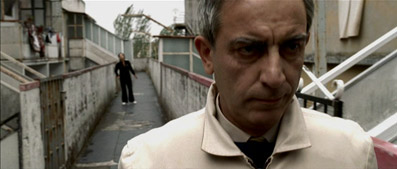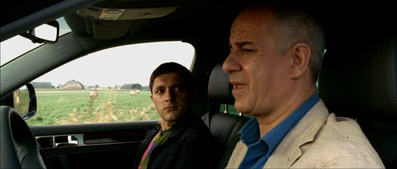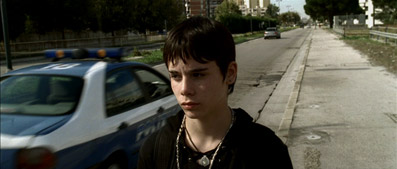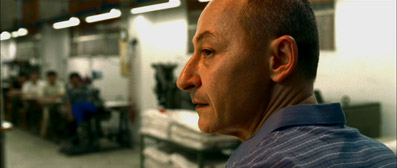| |
"Campania can get worse because you could cut into a Camorra group, but another ten could emerge from it." |
| |
Real world Galasso clan boss Pasquale Galasso |
Think Italian gangsters and you tend to think mafia, which is actually a generic term for a number of criminal organisations, usually with Italian roots. The most notorious of these is the Sicilian Cosa Nostra, whose world fame stems more from its criminal dealings in America and its portrayal in a certain well known book and subsequent movie trilogy than its activities on home turf. A number of high profile killings and gangland arrests have curbed the Cosa Nostra's power and influence somewhat in recent years, at least that's how the official story goes. Over in Naples, however, the situation is different. Here there are districts under such complete criminal control into which the police will not venture unless able to do so in force. Drug dealers are able to operate openly without fear of arrest, and killings and muggings are grimly routine. This is not the work of the Cosa Nostra, however, but a network of gangs known as the Comorra, the oldest and most widespread criminal organisation in Italy.
Do an internet search for the word Comorra and the collective results do not paint a pretty picture. A fair few of the top hits will be news stories about their takeover of the city's refuse disposal and how the resulting street-dumped rubbish and improperly disposed industrial waste is not only creating a health and image problem for Naples, but has become symbolic of the criminal rot that is eating away at the city's heart. In 2006, author Roberto Saviano published Gomorra, a detailed and damning expose of the full extent of the Camorra's power that identified key players in the organisation by name. The book won a number of international prizes, but to this day its author lives under 24-hour police protection following a a string of very real threats to his life. This apparently did nothing to dissuade Italian filmmaker Matteo Garrone, whose 2008 movie adaptation must surely run the risk of landing him in similarly hot water.

Gomorrah (the additional last consonant on the English language title is there to preserve the biblical reference) tells five concurrently running and intercut stories of lives touched in different ways by the presence and activities of the Comorra in the Scampia district of Naples, a Comorra stronghold. Totò is a young boy who makes grocery deliveries for his mother on a Comorra-controlled housing estate and sees a possible future for himself working for the local faction; Don Ciro is the gang's mild-mannered bag man, employed to deliver payments to the families of imprisoned gang members and a man increasingly concerned for his own safety and the welfare of one of the estate's female tenants; good natured and eager young Roberto lands a job with prospects assisting representative of the Camorra business interests in the illegal dumping of industrial waste; master tailor Pasquale is employed to produce designer dresses for Comorra-controlled outlets, but is offered a sizeable sum to moonlight for a competing Chinese factory; and Ciro and Carlo are two undisciplined young hoodlums who fancy themselves as gangsters but who cross the line when they steal a hoard of Comorra weapons.
Gomorrah arrived in the UK with some serious baggage. Widely and internationally acclaimed, it was the subject of a sizeable cover story in Sight & Sound, featured in many critics' top ten of 2008 lists, was labelled "the best gangster film since City of God," and won the Grand Prize at Cannes and a fair few awards elsewhere. And yet the most unexpected thing about it is that none of its main character arcs are all that surprising. Once the five stories are set up it won't be long before anyone with a few crime movies under their belt will have taken a good guess at how they will play out (if you're new to crime movies you might want to hop to the next paragraph to avoid what could well count as spoilers): the quiet gangland misfit will look for a safe way out when things get nasty; the cocky and undisciplined youngsters with no respect for the established criminal order will be taught a sharp lesson; the apprentice to the unprincipled waste dumper will realise the immorality of what he's involved in; the tailor who secretly betrays his bosses will be found out and incur their wrath; and the kid who hangs around with the local gang will either be traumatised back to family life or cross a moral boundary that seals his criminal future. And just for the record, these observations are from notes I made during the film's first twenty minutes.
But in spite of this, Gomorrah is still dynamite stuff. I'd even go as far as to suggest that the convention of these five narrative arcs has grown out of real world truths, and each has clearly been selected to highlight a particular aspect of the Camorra's destructive influence on the region and its citizens (a similar technique was employed in the multi-standed Syriana). In this respect, they serve their purpose well, diverse and distinctive enough to make an impression that is not lost in the story cross-cutting, and effectively illustrating the diversity of the Comorra's power. And while the five stories may play out largely to expectations, they all still deliver their share of jolts and surprises.

Like City of God, Gomorrah comes from the heart as well as the intellect, a crime movie made by those with a first-hand understanding of the world they are portraying. Its view of gangster life as ugly, unpricipled and destructive is the complete flipside of mafia romanticising of The Godfather and its ilk. Here there is no talk of honour and family or respect for either – the pyramid structure that defines mafia families, with their symbolic patriarchs, capos and foot soldiers, just doesn't exist here. It's replaced by a faction-based system that's been identified as both a key weakness and strength of the Camorra, for while entire clans can be destroyed by in-fighting, others are always ready to take their place, and there is no single individual to be assassinated or arrested that will effectively disable or even seriously inconvenience those working for or with him.
The apartment block around which much of the film's action is centred is effectively a war zone in which Comorra are the occupying and stabilising force. An imposing architectural malformation whose main concourse looks disturbingly like the inside of a dilapidated prison, its tenants are effectively under protection and control of specific Camorra factions. Choose the wrong one – and with the power structure forever on the move you're bound to sooner or later – or challenge their authority or the status quo and you'll likely end up with a bullet in the head. But within that structure, the occupying forces provide employment opportunities and potential positions of strength to the socially emasculated, albeit at great potential cost and gain.
Don Ciro and Titò are at opposite ends of this ever-rotating cycle. As Don Ciro nervously carries out his duties, ever fearful for his future, for the young Titò gang offers responsibility, comradeship and a taste of the high life usually denied someone of his age and social stature – he is, effectively, the next generation of Camorra soldier in the making. In a simple but superb scene captured in a single shot, Titò gets a small taste of the rewards this life may offer him as he is driven around the neighbourhood in a smart car with its stereo blasting and emulates his driver's cat-calls to local girls, only to be unexpectedly whipped out of the vehicle and back to reality by his irate mother. Both Don Ciro and Titò are later faced with difficult decisions and moral choices, one to free himself from an allegiance with a gang that the other is deperate to prove himself to, but that will require him to commit an act that will destroy what semblence of childhood innocence remains within him. In common with City of God, it's this willingness of the gangs to employ children for anything from drug trafficking to driving waste haulage trucks and much worse that proves most disconcerting, and it's definitely Titò's youth that gives the shocking conclusion to his story that extra gut-punch.

The two most obviously fated characters are Ciro and Carlo, self-confidently brash teenagers who act out the climax to De Palma's Scarface, rob local drug dealers of their wares and ignore the warnings to cool it from the local gang boss, whom they treat with contempt. It's they who feature in one of the film's most telling scenes, when they strip to their underpants and let rip with a small armoury of stolen guns like hyperactive kids in an explosive candy store. It's a firearms-assisted display of fuck-you machismo that is quickly deflated when they are grabbed at gunpoint and threatened with dire consequences if the weapons are not returned, an assault that prompts these would-be tough guys to wail like frightened girls.
Perhaps the most instantly likeable of the key protagonists is the world-weary Pasquale, whose furtive night-time trips to the Chinese dressmaking factory may have been initially spurred by the considerable fee he is offered, but which soon see him immersing himself in his new role and engaging with his employers and their workers on a personal level. In his daytime post he is little more than a mob lacky, but by night he is a maestro who takes pride in his work and the developing the skills of his eager students. When Camorra reaction comes, as you know it must, it does so in sudden and startling fashion in a sequence that is both jarringly real and yet still rife with telling symbolism.
Director Garrone takes a deliberately observational approach, with Marco Onorato's floating camera drifting with characters and settling on faces to allow their inward emotions to seep subtly onto the screen. Every now and then, Garonne allows himself a small flourish, as when we hear the world from the inside of a worn chemical suit, or in the stunning top-shot that follows one character as he navigates the aftermath of a gang massacre (all the more impressive when you realise that no other angle would have shown the results of the killings so effectively). The scope frame may kick against the otherwise documentary feel, but it effectively isolates figures within their controlling environment, while the absence of a traditional score allows the emotion of a scene to emerge unforced from the actions and characters rather than from the director's chair. Perhaps Garrone's greatest achievement is the deft way he moves between the five stories, making them feel part of an interrelated whole without ever having to lay out clear paths between them.
It's a testament to the naturalistic cast that although we're often dealing with extreme emotions here, there's never a sense of overstatement. Even Cici and Carlo's bellowed bravado feels somehow real, and Roberto's slow realisation that he's in the wrong business is achieved not via a Hollywood-style emotional breakdown to a single defining moment, but through the smallest of facial reactions to boss Franco's behaviour during a series of troubling encounters. As with so much European and (especially) Eastern European cinema, the characters here feel like the real deal, cast for authenticity rather than the fame of the actors or the demands of the funding body.

There's so much to talk about with Gomorrah, but it's a film to be experienced rather than read about, so I'll leave you with this simple statement of appreciation, that everything you've heard about it, all the praise and all of the accolades that have laded at its feet, are deserved. Yes, the story arcs are familiar, but their detail will still keep you on the hop, and this is one of those films where every element comes together so smoothly and invisibly that you're watching the credits roll before you start to appreciate the full mastery of what you've just witnessed. The film ends on a few sobering textual facts about the real Comorra, and saves its most eye-opening illustration of the extent of the organisation's reach – designed, no doubt, to raise American awareness of the their activities – for last.
A pristine anamorphic 2.35:1 transfer that scores full marks on every criteria, particularly contrast, sharpness and colour reproduction – witness the opening tanning booth scene, whose bright vivid blues would once have caused stability and artefact issues for even slightly sub-standard digital transfers and would have bled all over the screen on VHS, but here they are rock solid. The film will also be released on Blu-ray, which I would imagine looks even more impressive.
Dolby 2.0 stereo or 5.1 surround are the choices on offer for the soundtrack. Want to guess which one is best? The stereo track is clear enough but a touch quiet and really centre-weighted, while the sound stage is more widely used on the 5.1 track, the surrounds being used to create a sense of place in street and apartment exterior scenes. Gunfire, crashes and explosions deliver a real wallop here, which adds to their ability to startle when required. The bass in the car stereo also has an appropriate degree of oomph.
Gomorrah – Five Stories (59:58)
A behind-the-scenes documentary that tends to sit back and watch the filmmakers at work, divided as the titles suggests into the filming of the five separate stories. The usual pleasures of seeing the surface stripped away to reveal the workings beneath are here, and there are a few small gems to enjoy, as when the production designer explains to the crew how the drugs are cut and prepared, having had the process demonstrated to him by a real dealer, or the crashing car that stops just ten centimetres short of a very expensive movie camera. Particularly interesting is the older actor who confirms the authenticity of the events portrayed, but puts it down to the organisation's new young intake, expressing a nostalgic appreciation for the Camorra of years past and the positive things they did for his community.

Deleted Scenes (13:21)
A number of deleted scenes (one is an alternate angle on a sequence that's in the film) that do not expand in any major way on the characters or plot but are interesting nonetheless. The best two involve the apartment block kids taunting the police and shouting support for arrested friends, and a key meeting between Pasquale and his boss that it would be unfair to elaborate on here.
Interview with Roberto Saviano (41:15)
The author of the book on which the film is based (and which he helped to script) describes how he first became interested in writing about the Camorra and talks extensively about the true-life stories behind the characters that appear in the film. There's plenty of eye-opening stuff here, but the really worrying bit comes when Saviano discusses the influence of Hollywood on the current generation of mafiosi, all of whom are movie buffs and who openly model themselves on modern Hollywood movie gangsters, Tony Montana being far and away the mobster's favourite.
Interview with the actors (10:07)
Actors Tony Servillo (Franco), Salvatore Cantalupo (Pasquale) and Gianfelice Imparato (Don Ciro) sit in the dark and talk about their characters and working with director Garrone with brief pauses for some behind-the-scenes photos and a horrid pop song.
Theatrical Trailer (2:00)
A niftily assembled piece that is riddled with spoilers, so don't watch this just before the movie proper.
Character arc conventions aside, Gomorrah delivers completely on its advance word promise, as both a compelling, multi-stranded crime drama and as an expose of a situation that few outside of the film's home turf are probably even aware of. It paints a grim picture of a district at the mercy of a powerful and dangerous criminal organisation, and if it prompts a few of those in international power to acknowledge the problem and start doing something about it then Saviano and Garrone will have done their job, and then some. Optimum's 2-disc DVD release is first rate, with a sparkling transfer and some pretty good extra features. Highly recommended.
|